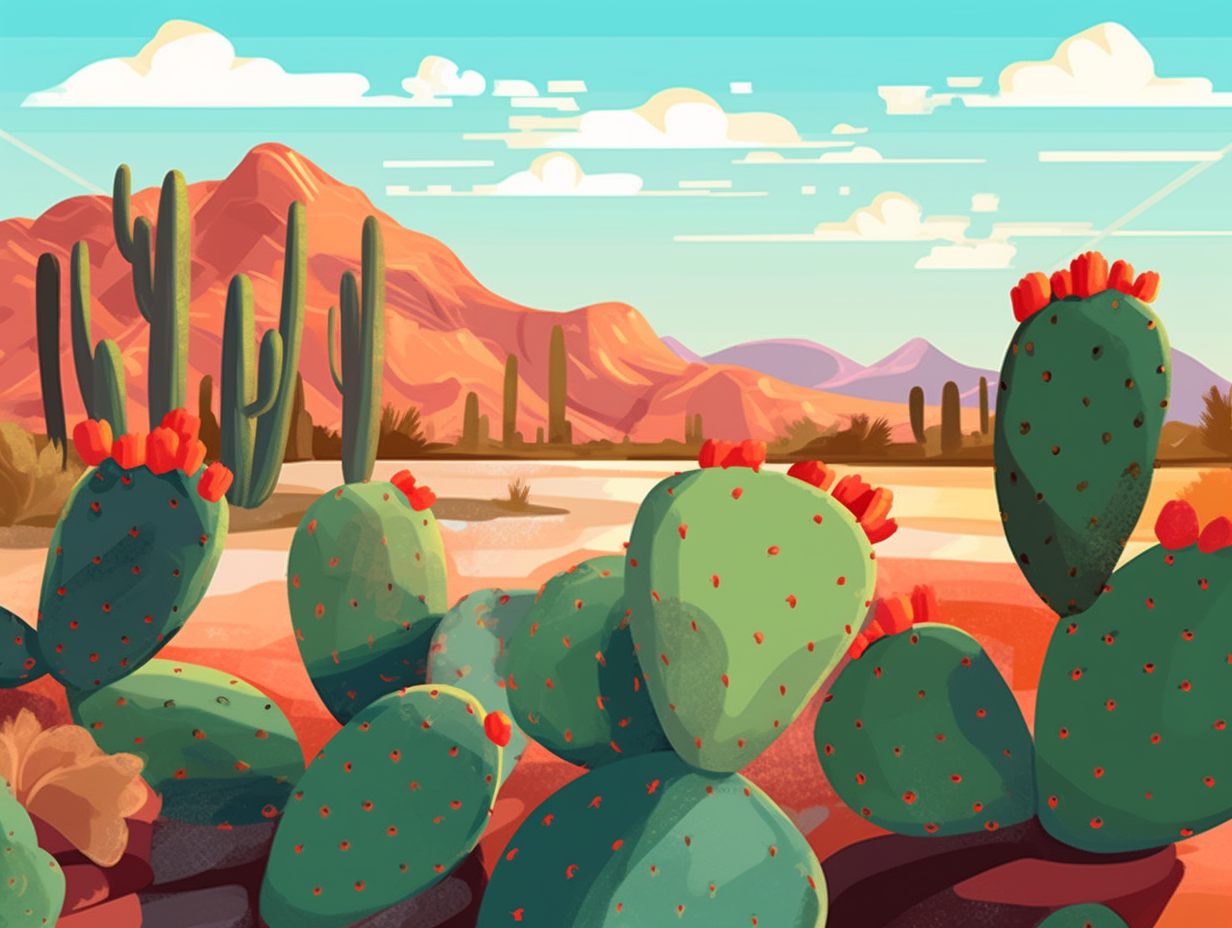Discover the Saguaro Cactus: 13 Fascinating Fun Facts You Never Knew!

1. Bats & Cacti: Nature's Matchmakers
Who needs matchmakers, when bats and cacti have perfect chemistry?: The lesser long-nosed bat, with its impressively long tongue, serves as the ultimate wingman to the saguaro cactus, becoming its primary night pollinator – sipping on nectar from the cactus flowers while simultaneously dispersing its pollens and plant seeds.
Source => nps.gov
2. Drought-Proof House Guest: Saguaro Cactus
If the saguaro cactus were a house guest, you'd definitely want it around during a drought—they're the true embodiment of water-wise! This living sponge could teach us all a thing or two about staying hydrated: The saguaro cactus, when fully soaked after a rainy season, can weigh between 3,200 to 4,800 pounds, making it one impressively hefty resident of the desert.
Source => desertmuseum.org

Did you know that the prickly pear cactus is more than just a desert beauty? It's a versatile culinary gem with a sweet flavor that can be enjoyed in candies, jams, salad dressings, and even margaritas! 🍽️🌵✨
=> Fun Facts about Prickly-Pear-Cactus
3. The Sluggish Growth of Saguaro Arms
Move over, slowpokes like sloths and snails: this prickly plant packs some seriously sluggish growth! In the race of life, the saguaro cactus is the tortoise – not the hare – when it comes to sprouting arms: astonishingly, it takes up to 100 years for a saguaro to grow its first arm, and in low precipitation areas, it might take even longer. The cactus truly branches out between 50 to 70 years of age, transforming from an unbranched youngster into a full-fledged, arm-bearing adult!
Source => nps.gov
4. Saguaro: The Jenga Champ of Cacti
The saguaro cactus: nature's favorite Jenga player who sometimes topples over after a heavy rainstorm because of its lightweight root system and insatiable thirst for water: These shallow yet wide-reaching roots can't support the plant once it becomes waterlogged in soggy soil, leading the cactus to potentially lose an arm or even tip over from the excessive weight of its stored reserves.
Source => nps.gov

5. Saguaro's Astonishing High School Reunion
If the saguaro cactus were a student, it would be the one snoozing through all the growth spurts of its peers: this slowpoke cactus can take an entire decade to reach a mere 1.5 inches tall. However, it eventually stuns everyone at the cactus' version of a high school reunion: with the right care, a saguaro can grow to a towering 40-60 feet height, proudly becoming one of the largest cacti you can find in the United States.
Source => desertmuseum.org
6. The Real Desert Heavyweight: Saguaro Cactus
Move over, Dwayne "The Rock" Johnson – the saguaro cactus is the real heavyweight champ of the desert, without even breaking a sweat under its prickly green exterior: Towering between 40-60 feet tall and weighing in at a whopping 4,800 pounds after a heavy drink of rainwater, this majestic cactus laughs in the face of a concert grand piano, weighing merely a fifth of its size.
Source => desertmuseum.org
7. Bahidaj: Nature's Vitamin-Packed Piñata
Who needs a grocery store in the desert when you've got nature's own vitamin-packed piñata? Behold, the Saguaro cactus: found solely in the Sonoran Desert, it produces a nutrient-dense fruit called bahidaj, which packs a punch with soluble fiber, protein, fat, and vitamin C and can be turned into syrup, jam, and even ceremonial wine.
Source => nativeseeds.org
8. Thirstiest Plant at the Desert Kegger
When the saguaro cactus throws a "desert kegger," it really knows how to chug the H2O: These towering, prickly party plants can grow up to 50 feet tall, live for over 150 years, and gulp down gallons upon gallons of water during infrequent desert downpours thanks to their radial root system and expandable accordion-like pleats.
Source => nps.gov
9. The Late Bloomers of the Cactus World
Much like a saguaro cactus finally deciding to "branch out" in the dating world after years of sticking to the single life, these prickly giants don't make their move until they're well into their 50s – and sometimes, it takes even longer: The branch sprouting in these cheeky cacti occurs anywhere from 50 to 100 years old, and while flowering starts around 35, arm growing is entirely dependent on factors like climate and location. These towering flora easily live to see 150-175 years, with some even stretching to a ripe old age of over 200 years.
Source => nps.gov

10. Rib-Tickling Fire Starters
In a heated saguaro situation that can only be described as rib-tickling – not only because their ribs are indeed wood-like structures, but also because they can save your life when things get fiery: the saguaro cactus ribs can be used to create fire-starting tools, having been a choice fuel and elemental ignition source for wild wanderers throughout the ages.
Source => ehow.com
11. Birdie Penthouses: Saguaro Edition
Saguaro cacti: The desert's version of birdie penthouses and feathery high-rises! Did you know these prickly giants double as both Wild West icons and avian apartments? Turns out, woodpeckers skillfully carve out cozy condos for owls, sparrows, and their feathery friends, while hawks prefer to perch in the saguaro's outstretched arms like royalty.
Source => houzz.com
12. Saguaro Cactus: Desert Airbnb Extraordinaire
If the saguaro cactus were a landlord, it'd be the one with the most popular desert Airbnb: saguaro is the 'it' place for creatures from Gila woodpeckers to Mexican Long-tongued bats looking for a quick snack, nesting spot, and everything in-between. No reservations needed: providing food, shelter, and nectar for an impressive guest list, including birds, bats, mammals, and reptiles, the saguaro cactus is the life of the Sonoran Desert party.
Source => nps.gov
13. Saguaro's Monumental Muscles & DIY Skills
Like a southwestern Groot flexing its biceps, the saguaro cactus showcases some monumental muscles as it matures, but some prefer to stick to their limbless lifestyles: These towering giants can grow up to an astounding 60 feet tall and weigh over 4,000 pounds when fully hydrated, with roots spreading only 4-6 inches apart and a single deep taproot burrowing over 2 feet. As if moonlighting as eco-friendly DIY enthusiasts, when the saguaro meets its end, its woody ribs can be repurposed for furniture, roofs, and fences, while its bird-carved cavities become makeshift water containers.
Source => desertmuseum.org
Related Fun Facts




















